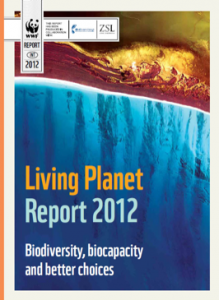Resource Title
Living Planet Report 2012: Biodiversity biocapacity and better choices
Summary
The Living Planet Report (LPR) is the world’s leading, science-based analysis on the health of our only planet and the impact of human activity.
The 2012 edition of the LPR highlights the tremendous pressure that humanity is putting on our planet. We are using 50 per cent more resources than the Earth can provide. By 2030, even two planets will not be enough. Our natural capital is declining and our Ecological Footprint is increasing. Urgent action is needed to ensure that we can live in harmony with nature.
Resource Details
Description
In this, the ninth edition of the Living Planet Reports, the key indices (the Living Planet Index, the global tropical index and the tropical freshwater index) again show unsustainable pressures on the planet. We now know that the demands on natural resources like fish, timber and food are rocketing to a level that is impossible to replenish sustainably. The report documents the changing state of biodiversity, ecosystems and humanity’s demand on natural resources; and explores the implications of these changes for biodiversity and human societies. The report highlights that current trends can still be reversed, through making better choices that place the natural world at the centre of economies, business models and lifestyles.
The report also shows the Ecological Footprint of humanity on the planet, showing a consistent trend of overconsumption exceeding the Earth’s biocapacity.
Utilising images provided by the European Space Agency, presenting the experiences of Kenyan farmer Margaret Wanjiru Mundia and including a special focus on the BRIC countries (Brazil, Russia, India and China) shows the lengths that this multiauthored report goes to by linking biodiversity, ecosystems, services and people globally to project what the planet will look like in 2050, and what we can (and must!) do to reverse these trends.
The supporting visual material for educators throughout is particularly good in this report and well worth using. For example, it is crammed with tailor made infographics, a glossary, charts, fact boxes, overlaid maps and originally conceived illustrations.
The report is divided into 4 chapters
- The state of the planet
- Why should we care
- What does the future hold
- Better choices for a living planet
Further reading
The LPR 2012 homepage contains a raft of support materials to explore the implications of the findings, play with the information and take action to reduce your own footprint. Here are direct links to some of this material:
Learn
- How have key species populations have fared since 1970?
- Why do temperate species do better than tropical species?
- Who comes off worse: terrestrial or freshwater animals?
- Which countries make the most demands on our planet, and which the least?
- How is this related to what we earn?
- How does the loss of species diversity affect you and me?
Play with the information
- Use the Interactive Footprint Calculator to find your country and see how it compares to others.
- Watch how the index for species populations move and change over time.
- See what makes up the biggest components of our water footprint (from 2010)
Reduce my footprint
Available from:
Download Living Planet Report 2012 PDF (16.2MB)
Links to the report and specific sections, inforgaphics, short blogs and snippets from the report from the World Wildlife Fund (WWF) are all available below.

